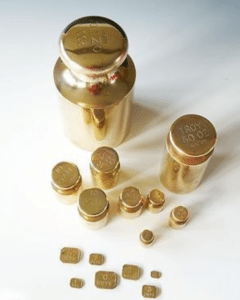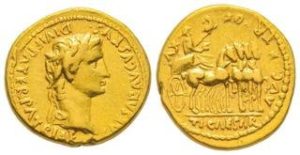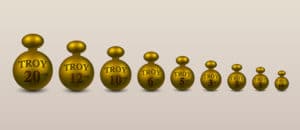What Is a Troy Ounce?
A Troy ounce is an imperial unit of weight that is equal to 1.09711 ounces.
It is used primarily in the United States and is more commonly known as a “golden ounce.”
The Troy ounce was originally used to weigh precious metals, such as gold and silver. Today, it is still used for this purpose, as well as for measuring medicine and gemstones.
The Troy system of weights is a legacy from the Romans.
However, its modern use is associated with England—the place where it was first implemented in the 13th century.
Avoirdupois Pounds
The weight of a troy ounce is measured in avoirdupois pounds.
This means that one troy ounce equals 1.09711 avoirdupois pounds.
There are only 12 troy ounces to one troy pound, whereas there are 16 regular ounces to a regular pound.
Troy System For Precious Metals
The Troy ounce is still used in many different industries today.
For example, it is the standard unit of weight used by the United States Mint to produce coins.
The Royal Canadian Mint also uses the Troy ounce as its standard unit of weight.
In fact, most of the world’s major mints use the Troy system for their precious metal products. The use of this system helps to ensure accuracy and consistency when measuring these materials.
What does Troy ounce mean?
A. 1.09711 ounces
B. 1.555… avoirdupois oz
C. 0.001 imperial tons
D. 0.278 kilograms
Etymology of the word “ounce” can be traced to medieval Latin, from an earlier Latin word, “uncia,” which means “twelfth.”
This is in reference to the fact that there are 12 Troy ounces to a Troy pound, whereas there are 16 regular ounces to a regular pound.
The pronunciation of “ounce” has changed over time, with the first syllable once rhyming with “douse.” However, the modern pronunciation rhymes with “bounce.”
There is a difference between the spelling of the word “troy” as it refers to system of weights and the word “troy” as it refers to place.
How is Troy weight measured?
Troy weight is measured in units of pounds and ounces. For example, a coin with a mass of 5.6 grams has a weight of 3 troy ounces.
What are some common Troy weight measurements?
Some common Troy weight measurements include: the troy pound, troy ounce, pennyweight, and grains.

How is Troy weight different from other systems of mass measurement?
Troy weight is different from other systems of mass measurement in that it is based on a unit of weight (the troy pound) that is smaller than the standard pound.
Troy weight is also divided into 12 ounces, while other systems are usually divided into 16 ounces.
This makes Troy weight more convenient for measuring small masses.
Why was Troy weight eventually replaced by other systems?
Troy weight was eventually replaced by other systems because it is more difficult to use for measuring larger masses.
Additionally, Troy weight is based on an obsolete unit of weight (the troy pound), while other systems are based on the standard pound.
As a result, Troy weight is not used in many places today.

How is Troy weight different from apothecary weight?
Troy weight and apothecary weight are very similar in that they are both units of mass in the English system of measurement.
The main difference between the two systems is that in Troy weight, a pound weights 12 ounces, while in apothecary weight, a pound weights 16 ounces.
This means that apothecary weight is more common than Troy weight in the United States.
What are some common uses for Troy weight?
Troy weight is commonly used for measuring the mass of precious metals and gemstones. It is also used for measuring pharmaceutical products. Some other common uses include:
– Measuring gold, silver, diamonds, and other precious metals
– Determining the weight of medications in capsules or tablets
– Determining the price of gold per troy ounce (in American markets)
How is Troy weight different from metric weight?
Troy weight is different from metric weight in that it is a unit of mass in the English system of measurement, while metric weight is a unit of mass in the metric system.
Additionally, Troy weight is divided into 12 ounces, while metric weight is typically divided into 100 grams.
This makes Troy weight less convenient for measuring larger masses.
What were Troy weights used for in the past?
Troy weight was originally developed to measure precious metals and gemstones, but it has since evolved into a system of measure that is useful for measuring pharmaceutical products and other common items such as alcohol and gasoline.
Why is Troy weight not used as much as it used to be?
Troy weight is not used as much as it used to be because it is more difficult to use for measuring larger masses than other systems of mass measurement, such as metric weight.
Additionally, Troy weight is based on an obsolete unit of weight (the Troy pound), while other systems are based on the standard pound.
As a result, Troy weight is not used in many places today.

What is the metric system of mass measurement?
The metric system of mass measurement is a unit of mass in the metric system.
The metric system is based on the International System of Units (SI), and it is used in most countries around the world. The metric system is composed of units that are larger or smaller than the standard pound.
For example, the kilogram is larger than the pound, and the milligram is smaller than the pound.
What are some common metric mass measurements?
Some common metric mass measurements include: the kilogram, gram, and milligram.
These units are all based on the standard kilogram, which is equal to 1,000 grams.
What is the relationship between metric mass and standard weight?
Metric mass is different from standard weight in that it is a unit of measure in the metric system, while standard weight is a unit of measure in the English system.
Additionally, one pound is generally equal to 16 ounces in standard weight, while one kilogram is generally equal to 2.2 pounds in metric mass.
This means that metric mass is typically less convenient than standard weight for measuring larger masses.
What system of mass measurement is most commonly used in the United States?
The apothecary system of mass measurement is most commonly used in the United States.
This system is based on the English system of measurement, and it is composed of units that are larger or smaller than the standard pound.
For example, the apothecary pound is larger than the standard pound, and the apothecary ounce is smaller than the standard ounce.
Additional information about Troy weights can be found here: Wikipedia Troy weights
How many Troy ounces are in a pound?
There are twelve Troy ounces in every pound. This means that there are 288 Troy ounces in every kilogram:
288/12 = 24 (to the nearest Troy ounce)
1 kilogram = 1,000 grams
1,000 grams X 0.7 = 700 (to the nearest gram)
700 grams X 12 = 8,400 (to the nearest Troy ounce)
There are also 480 grains in a Troy ounce. This means that there are 3,600 grains in a kilogram:
3,600/480 = 7.5 (to two decimal places)
How much larger is a pound of Troy weight than a pound in US measurements?
A pound of Troy weight is approximately 1.2 times larger than a pound in US measurements.
This means that a pound of apothecary weight is approximately 1.2 pounds in standard weight in the English system of measurement.
How do you calculate what something weighs in Troy ounces?
You can calculate an item’s weight in Troy ounces by dividing the number of standard ounces that it weighs by twelve.
This means that there are twelve Troy ounces in every standard ounce.
For example, something that weighs 10 standard ounces would weigh 4.8 Troy ounces:
10/12 = 0.8333 (to two decimal places)
10 X 0.8333 = 8.333 (to two decimal places)
8.333/12 = 0.7 (to two decimal places)
0.7 Troy ounces = 7 Troy ounces (to the nearest ounce)
Is Troy weight more complex than modern systems of measurement?
The Troy system of measurement is more complex than the modern metric and standard systems.
This complexity can be seen in the variety of units that are used in the Troy system, as well as in the fact that Troy weight is not based on a decimal system.
Additionally, the Troy system was developed specifically for measuring precious metals and gemstones, while the modern systems of measurement are more general in nature.
However, the Troy system is also less commonly used than the other two systems, so it may be less familiar to those who are not specifically trained in metrology.
14/16 = 0.875 (to two decimal places)
1 pound = 16 ounces
16 ounces X 0.875 = 13.5 (to two decimal places)
13.5 ounces X 16 = 220 (to the nearest ounce)
1.2 X 16 = 18 (to the nearest whole pound)
18/16 = 1.125 (to two decimal places)
1 kilogram = 1,000 grams
Below are the Top 4 Precious Metal firms that we have chosen, as being amongst the most reputable Gold IRA companies in the industry.
Click here to read our reviews

|
The Bottom Line
In order to avoid confusion, you should always convert from one type of weight measurement to the other if necessary.
For example, a pound is 16 ounces and a kilogram is 1000 grams.
The two measurements are often used interchangeably because they’re both based on dividing by sixteen.
If it’s not possible or practical for you to switch between metric and imperial units, then try converting as much as possible so that your calculations will be more accurate when working with different weights in pounds and kilograms.
When all else fails, just remember that 1 kg equals 2 lb (1kg=2lb).
This conversion can help you calculate how many troy ounces there are in an apothecary ounce or vice versa! Be sure to use this




